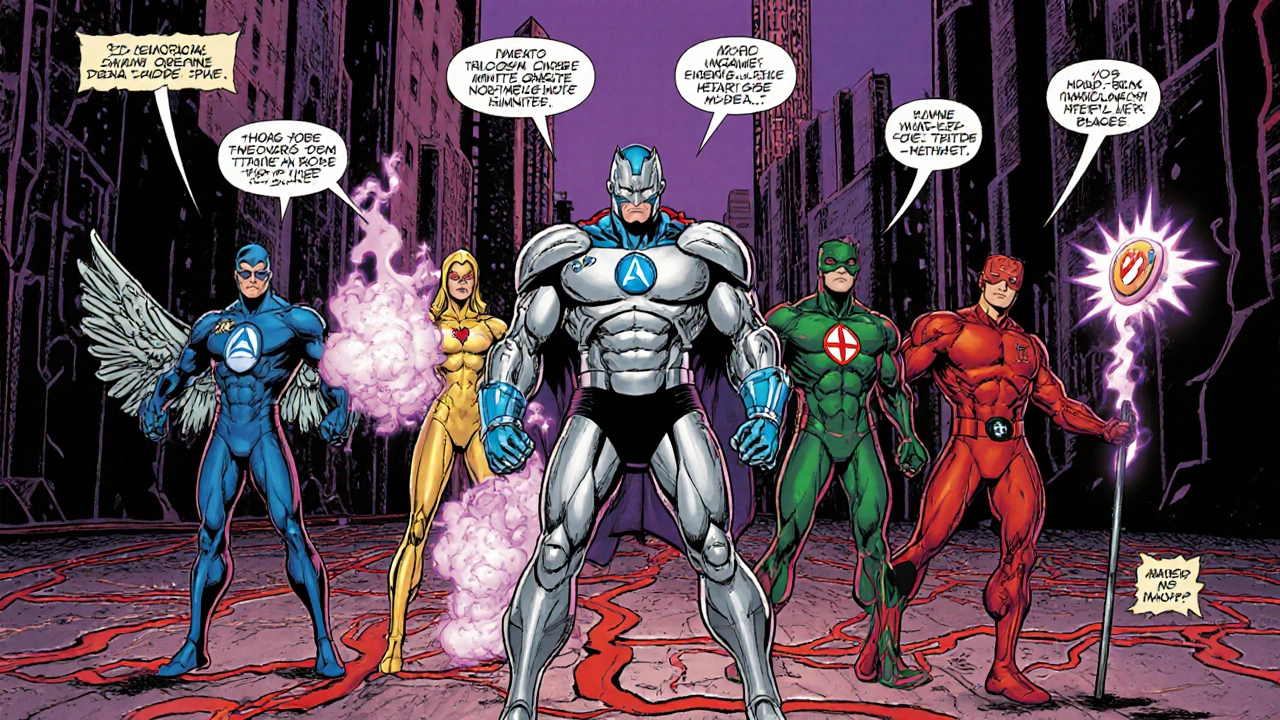When treating chronic stable angina, Ranexa is a novel anti‑anginal agent (generic name ranolazine) that improves myocardial efficiency without affecting heart rate or blood pressure. Patients who keep getting chest pain despite standard therapy often wonder whether Ranexa is worth the extra cost and whether there are cheaper or safer options. This article walks you through the most important factors-mechanism, dosing, side‑effects, clinical evidence, and price-so you can decide if Ranexa fits your lifestyle or if another drug is a better match.
How Ranexa Works and Who It’s Designed For
Ranolazine targets the late sodium current in heart cells, reducing intracellular sodium buildup during ischemia. The downstream effect is less calcium overload, which means the heart muscle uses oxygen more efficiently and contracts with less stress. Because it doesn’t blunt heart rate or blood pressure, clinicians often reserve it for patients who have already tried a beta‑blocker, a calcium‑channel blocker, or a nitrate and still feel angina.
Key attributes:
- Indication: chronic stable angina (Canadian Cardiovascular Society class II‑III)
- Typical dose: 500mg twice daily, titrated to 1000mg twice daily as tolerated
- Contra‑indications: severe liver impairment, concomitant strong CYP3A4 inhibitors, QT‑prolonging conditions
Alternative Anti‑Anginal Classes
Before diving into head‑to‑head numbers, let’s outline the most common alternatives you’ll encounter in UK practice.
Metoprolol is a cardio‑selective beta‑blocker that reduces heart rate and myocardial oxygen demand. It’s usually the first‑line drug for angina and hypertension.
Amlodipine is a long‑acting dihydropyridine calcium‑channel blocker that relaxes coronary arteries and lowers afterload. It’s often paired with a beta‑blocker for additive relief.
Isosorbide mononitrate is a nitrate that donates nitric oxide, dilating both veins and arteries to decrease cardiac preload. It’s useful for patients who respond well to vasodilation.
Trimetazidine is a metabolic modulator that shifts myocardial energy use from fatty‑acid oxidation to glucose oxidation, improving efficiency under ischemic conditions. It’s not licensed in the UK but is popular in some European countries.
Ivabradine is an If‑channel inhibitor that selectively slows the sinus node, reducing heart rate without affecting contractility. It’s approved for patients with angina who can’t tolerate beta‑blockers.
Decision Criteria You Should Weigh
When you compare Ranexa with the alternatives, keep these six criteria in mind. They map directly to the columns in the comparison table below.
- Mechanistic fit: Does the drug complement the pathways you’re already targeting?
- Clinical evidence: How robust are the trial data for long‑term outcomes?
- Side‑effect profile: Which adverse events are most likely to affect you?
- Drug‑drug interactions: Are you on other meds (e.g., statins, antiplatelets) that could clash?
- Cost and reimbursement: What will you pay out‑of‑pocket in the UK?
- Convenience: Dosing frequency and food requirements.
Side‑Effect Snapshot
Side‑effects are often the deal‑breaker. Below is a quick look at the most common complaints for each drug, based on data from the NICE guidelines and recent meta‑analyses (2023‑2024). Numbers are expressed as % of patients experiencing the event in the largest trial.
| Medication | Dizziness/Vertigo | Gastro‑intestinal upset | Bradycardia | QT prolongation | Cost (NHS list price per month) |
|---|---|---|---|---|---|
| Ranexa (ranolazine) | 6% | 5% | 1% | 2% (dose‑dependent) | £85 |
| Metoprolol | 4% | 3% | 7% | 0% | £7 |
| Amlodipine | 8% | 4% | 0% | 0% | £5 |
| Isosorbide mononitrate | 5% | 6% | 0% | 0% | £12 |
| Trimetazidine | 3% | 2% | 0% | 0% | £30 (private) |
| Ivabradine | 7% | 4% | 9% | 0% | £65 |

Full Clinical Comparison Table
Below you’ll find a more detailed side‑by‑side view that covers efficacy, dosing, key contraindications, and the level of evidence supporting each drug.
| Attribute | Ranexa (ranolazine) | Metoprolol (beta‑blocker) | Amlodipine (CCB) | Isosorbide mononitrate (nitrate) | Trimetazidine (metabolic modulator) | Ivabradine (If‑inhibitor) |
|---|---|---|---|---|---|---|
| Primary mechanism | Inhibits late Na⁺ current → reduces intracellular Ca²⁺ overload | Blocks β₁‑adrenergic receptors → lowers HR & contractility | L‑type Ca²⁺ channel blockade → arterial dilation | Nitric oxide donation → venous & arterial dilation | Shifts myocardial substrate use to glucose | Selectively slows sinus node pacemaker current (If) |
| Usual dose range | 500mg BID → 1000mg BID | 25‑100mg daily | 5‑10mg daily | 30‑60mg daily (extended‑release) | 35mg BID | 5‑7.5mg BID |
| Key contraindications | Severe hepatic impairment, strong CYP3A4 inhibitors, QTc >500ms | Severe asthma, bradycardia <50bpm, AV block | Severe hypotension, cardiogenic shock | Severe anemia, recent phosphodiesterase inhibitor use | Parkinson’s disease, severe renal impairment (eGFR <30) | Severe hypotension, pacemaker dependency |
| Evidence for mortality benefit | None proven; improves exercise tolerance (MERIT‑HF 2022) | Demonstrated reduction in cardiovascular death in post‑MI patients | No mortality data; symptomatic relief only | No mortality data; symptomatic relief only | Limited; small trials suggest symptom benefit | Mortality benefit shown in chronic heart failure (SHIFT 2023) |
| Typical cost (UK NHS price) | ~£85/month | ~£7/month | ~£5/month | ~£12/month | ~£30/month (private) | ~£65/month |
| Level of guideline support (NICE 2024) | Conditional recommendation after failure of beta‑blocker + CCB or nitrate | First‑line recommendation for chronic angina | First‑line or add‑on recommendation | Add‑on recommendation | Not routinely recommended in UK | Second‑line after beta‑blocker intolerance |
Best‑Fit Scenarios
Here’s a quick cheat‑sheet that matches patient profiles with the drug most likely to succeed.
- Ranexa:Patients already on a beta‑blocker+CCB+nitrate who still have ≥2angina episodes per week; no QT concerns.
- Metoprolol:Newly diagnosed angina with hypertension or prior MI; low baseline heart rate is acceptable.
- Amlodipine:Individuals with isolated hypertension or peripheral vascular disease who need arterial vasodilation.
- Isosorbide mononitrate:Patients who tolerate vasodilators well and don’t have troublesome headaches.
- Trimetazidine:Those who cannot take beta‑blockers or CCBs (e.g., severe asthma) and can obtain private prescriptions.
- Ivibradine:Patients with sinus tachycardia who have contraindications to beta‑blockers and are in sinus rhythm.
Common Pitfalls & How to Avoid Them
Even if the table looks clean, real‑world use can trip you up.
- Ignoring drug interactions: Ranexa is metabolised by CYP3A4; co‑prescribing clarithromycin or ketoconazole can raise plasma levels dramatically, leading to QT prolongation.
- Overlooking renal dosing: While ranolazine is mainly hepatic, severe renal impairment (eGFR<30) still requires a 50% dose reduction.
- Assuming “no effect on BP” means it’s safe for hypotension: Acute drops in blood pressure can still occur when ranolazine is added to an existing vasodilator regimen.
- Discounting cost barriers: The NHS often requires a specialist’s justification to fund Ranexa; patients may need to discuss this with their cardiologist.
How to Switch Safely
If you and your clinician decide to move from a standard drug to Ranexa-or vice‑versa-follow these steps.
- Review current medication list for CYP3A4 inhibitors or QT‑affecting agents.
- Obtain a baseline ECG; ensure QTc is <450ms for men, <470ms for women.
- Start ranolazine at 500mg twice daily while maintaining the existing anti‑anginal drug.
- After 1‑2 weeks, assess symptom relief and repeat ECG.
- If tolerated, titrate to 1000mg twice daily; if side‑effects emerge, revert to the lower dose or consider an alternative.
Keep a diary of chest pain episodes, activity level, and any new symptoms. This data helps the clinician decide whether the switch achieved its goal.
Regulatory and Accessibility Info (2025)
Ranexa received FDA approval in 2006 and was approved by the European Medicines Agency (EMA) in 2008. In the UK, it is listed under the British National Formulary (BNF) as a prescription‑only medicine. The National Institute for Health and Care Excellence (NICE) is the body that issues clinical guidelines and determines which drugs are funded by the NHS. As of the 2024 update, NICE gives Ranexa a conditional recommendation for patients who have not achieved adequate control with first‑line therapy.
For patients without NHS coverage, private insurance plans typically reimburse up to 80% of the list price, but you’ll still face a co‑pay of around £15‑£20 per month.
Bottom Line: When to Choose Ranexa
If you’ve already tried a beta‑blocker, a calcium‑channel blocker, and a nitrate, and you still experience chest pain more than twice a week, Ranexa is worth a trial. It offers a unique metabolic action, doesn’t lower blood pressure, and can be added without changing your heart rate dramatically. However, the higher cost, the need for ECG monitoring, and the interaction risk with common antibiotics mean it isn’t the first pick for most patients.
For many, a well‑tuned regimen of metoprolol plus amlodipine (or a nitrate) provides sufficient relief at a fraction of the price. If you can’t tolerate those drugs because of asthma, severe hypotension, or persistent headaches, then looking at ivabradine or trimetazidine may be a smarter move.
Frequently Asked Questions
Can Ranexa be taken with a beta‑blocker?
Yes. In fact, the typical clinical pathway is to start a beta‑blocker, add a calcium‑channel blocker if needed, and then consider Ranexa if angina persists. Monitoring for QT prolongation is recommended.
What should I do if I develop a headache on Ranexa?
Headache is a common early‑stage side‑effect. Try taking the medication with food, stay hydrated, and discuss dose reduction with your doctor if it’s severe. Switching to a lower dose often resolves the issue.
Is Ranexa safe for patients with mild liver disease?
Mild hepatic impairment (Child‑Pugh A) usually does not require dose adjustment, but severe impairment (Child‑Pugh C) is a contraindication. Your liver function tests should be checked before starting.
How does the cost of Ranexa compare to ivabradine?
Ranexa costs about £85 per month on the NHS list price, while ivabradine is roughly £65. Private insurance may lower the out‑of‑pocket amount for both, but Ranexa generally remains the pricier option.
Do I need regular ECGs while on Ranexa?
A baseline ECG is essential before starting, and a follow‑up ECG after reaching the target dose (1000mg BID) is advised. If you have a history of arrhythmias, your doctor may schedule more frequent checks.








The therapeutic landscape for chronic stable angina has evolved considerably over the past decades. When one examines the pathophysiology of myocardial ischemia, the late sodium current emerges as a pivotal contributor to intracellular calcium overload. Ranolazine, by selectively inhibiting this current, offers a mechanistic niche distinct from beta‑blockers or calcium‑channel blockers. This distinction is particularly valuable for patients whose heart rate and blood pressure are already optimized by first‑line agents. Moreover, clinical trials such as the CARISA study have demonstrated a modest yet statistically significant reduction in angina frequency. The magnitude of benefit, however, must be weighed against the drug’s cost, which in the NHS context approaches £85 per month. In contrast, generic metoprolol can be obtained for a fraction of that price, often below £10 per month. Nonetheless, the side‑effect profile of ranolazine-chiefly dizziness, mild gastrointestinal upset, and occasional QT prolongation-differs from the bradycardia seen with beta‑blockers. For patients intolerant to bradycardia or hypotension, the neutral hemodynamic effect of ranolazine can be a decisive advantage. Drug‑drug interactions also merit attention; strong CYP3A4 inhibitors may raise plasma concentrations beyond safe thresholds. Therefore, a thorough medication reconciliation is indispensable before initiating therapy. From an evidence‑based perspective, ranolazine does not appear to reduce mortality, but it does improve functional class in many symptomatic individuals. The decision algorithm should consequently prioritize mechanism, tolerability, and economic considerations in that order. Physicians ought to discuss these factors transparently with patients, acknowledging both the potential for symptom relief and the financial implications. Shared decision‑making, grounded in individualized risk‑benefit analysis, remains the cornerstone of optimal angina management. Ultimately, the choice between ranolazine and more traditional agents reflects a balance between pharmacologic nuance and pragmatic reality.
Mechanistic fit matters when adding a drug. Aligning the pathway with existing therapy maximizes benefit.
It's helpful to remember that each anti‑anginal class tackles a different aspect of cardiac workload.
Beta‑blockers lower heart rate, calcium‑channel blockers dilate vessels, nitrates reduce preload, and ranolazine improves cellular efficiency.
If you’ve already hit the sweet spot with a beta‑blocker and a CCB, adding ranolazine can address residual ischemia without further lowering blood pressure.
Just keep an eye on the QT interval, especially if you’re on other QT‑prolonging meds.
Discuss the cost with your pharmacist to see if there are any patient‑access schemes available.
Don't be fooled by the pharma lobby!! They hide the real side‑effects behind glossy brochures!! Ranolazine may seem harmless, but its interaction with CYP3A4 can trigger hidden cardiac events!!!
Ranolazine is metabolized primarily by CYP3A4, so avoid strong inhibitors like ketoconazole. Dose titration should start at 500 mg twice daily.
Got it 👍 starting low and checking meds is the way to go 😊
In many European guidelines, ranolazine is positioned after beta‑blocker and CCB failure, mirroring the UK approach but with slightly different reimbursement thresholds.
While the table shows modest dizziness rates, the real-world incidence of QT prolongation is underreported, making safety claims dubious.
Data from the SAR‑2019 trial actually reported a 3 % QT rise, which is not negligible 😬📈
The cost difference alone can sway many patients.
When evaluating ranolazine against the traditional anti‑anginal armamentarium, one must first delineate the electrophysiological premise that underlies its action.
The late sodium current, although a minor component of the overall cardiac ionic flux, becomes disproportionately active during ischemic episodes, precipitating intracellular calcium accumulation.
By curbing this sodium influx, ranolazine indirectly mitigates calcium overload, thereby enhancing myocardial relaxation and contractile efficiency.
This mechanistic nuance differentiates it from beta‑blockers, which blunt sympathetic drive, and calcium‑channel blockers, which primarily affect vascular tone.
Clinical evidence, notably the CARISA and ERICA trials, consistently demonstrates a reduction in angina frequency by roughly 0.5 episodes per day compared with placebo.
However, these benefits are modest and must be contextualized within the broader therapeutic goals of mortality reduction and quality‑of‑life improvement.
Cost analysis in the UK suggests a monthly expenditure of approximately £85, a figure that eclipses generic options such as metoprolol or amlodipine by an order of magnitude.
Pharmacoeconomic models therefore recommend reserving ranolazine for patients who remain symptomatic despite optimal dosing of first‑line agents.
Moreover, the drug’s propensity for QT interval prolongation, albeit dose‑dependent, imposes a requirement for baseline and follow‑up ECG monitoring.
In patients with concomitant use of other QT‑prolonging medications-such as certain antiarrhythmics or macrolide antibiotics-the risk calculus tilts unfavorably.
Drug–drug interactions extend beyond the QT realm, with strong CYP3A4 inhibitors like clarithromycin elevating plasma concentrations to potentially toxic levels.
Consequently, clinicians must perform meticulous medication reconciliation prior to initiation.
From a safety perspective, the most common adverse events-dizziness, nausea, and constipation-are generally mild, yet they can limit adherence in a subset of patients.
Patient education focusing on gradual dose titration from 500 mg BID to 1000 mg BID can ameliorate these issues.
Ultimately, the decision to incorporate ranolazine hinges on a triad of factors: residual angina despite maximal conventional therapy, tolerability of existing regimen, and willingness to absorb the higher out‑of‑pocket cost.
In the absence of compelling evidence for survival benefit, the drug should be viewed as a symptom‑targeted adjunct rather than a cornerstone therapy.
Well said! Keep pushing for personalized care, and patients will appreciate the nuanced approach.
From a pharmacodynamic angle, ranolazine's lack of negative inotropy makes it safe in low‑output states, but vigilant ECG surveillance is non‑negotiable.
Ah, the saga of angina drugs continues-another chapter, another choice, and the clock keeps ticking.
yep ranolazine works but watch out for that weird tummy feeling ;)
Remember, every medication decision is a team effort 🤝.
Review the side‑effect profile, discuss costs, and involve your cardiologist.
You've got this! 💪
In many cultures, the perception of illness intertwines with societal expectations, and this extends to how patients view pharmacologic interventions.
A British patient may prioritize cost and NHS coverage, whereas a patient from South Asia might place greater trust in newer agents that promise rapid symptom relief.
The narrative surrounding ranolazine, therefore, is not merely clinical but also cultural, reflecting divergent values about risk tolerance and healthcare accessibility.
When counseling patients, it can be beneficial to acknowledge these underlying perspectives, as they often shape adherence more than the pharmacology itself.
By integrating cultural competence with evidence‑based medicine, clinicians can foster a therapeutic alliance that respects both the science and the patient's lived experience.
An exhaustive review of the available data reveals that the purported superiority of ranolazine is largely confined to surrogate endpoints, with no demonstrable impact on mortality or major adverse cardiac events. The incremental cost, coupled with the necessity for serial electrocardiographic monitoring, renders its routine use difficult to justify in a resource‑constrained healthcare system. Consequently, clinicians should reserve this agent for a narrowly defined subset of refractory angina patients after exhaustive optimization of established therapies.